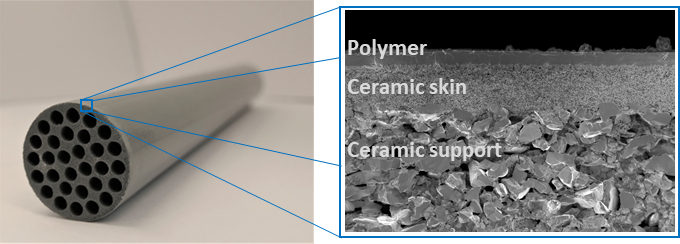Tailored polymer membranes for membrane reactor
- 22/05/2023
In the context of the project MACBETH (Membranes And Catalysts Beyond Economic and Technological Hurdles) composite membranes are developed. The composite membranes consists of a ceramic porous support structure, a porous ceramic skin and a dense, defect free polymeric separation layer for membrane reactor applications. The used application, in the MACBETH case the hydroformylation reaction with the associated reaction conditions (e.g.: support, temperature, pressures, reactants, products, catalyst, …), defines the used polymeric separation layer. For the hydroformylation membrane reactor, the porous ceramic support is coated with a dense polydimethylsiloxane (PDMS) layer. PDMS is chosen, because the polymer is resistant to the harsh reaction conditions and has good separation performance towards the product n-pentanal. In the figure, an example of a composite membrane with ceramic porous support structure, porous ceramic skin and dense polymeric separation layer of PDMS is shown.
During the project different ceramic support materials with pore sizes (up to 2 μm) are coated with polymers (e.g.: silicone, Pebax®, TPXTM, polyimide) to obtain a toolbox for composite membranes and to understand the coatability of the different polymers on porous ceramics. This toolbox of tailored polymer membranes helps to understand the coating feasibility and the coating conditions for further membrane reactor applications.
For more detailed information, please contact the MACBETH partner Helmholtz-Zentrum hereon GmbH.

